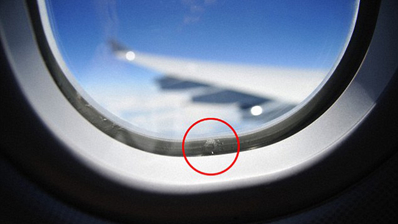So THAT'S Why Plane Windows Have Holes!
- Publish date
- Wednesday, 13 May 2015, 10:32AM

Have you ever noticed the small hole at the bottom of an airplane window?
It's a common feature on passenger planes, and now an expert has revealed that this seemingly insignificant hole plays an important safety role.
The hole helps to regulate how much pressure from the cabin is exerted onto the window's panes and it makes sure that if the window is going to break, the outer pane goes first.
The question was posed by Robbie Gonzalez from iO9 to director of technology Marlowe Moncur, from GKN Aerospace.
He referred to this 'breather hole' acts as a bleed valve.
A patent filed by Daimlerchrysler Aerospace Airbus in 1997 explained that this 'air conduit' helps maintain 'external atmospheric pressure inside' the panes.
On a plane, the air is pressurised by engines that compress it as it moves through a series of fans.
To maintain cabin pressure, even at high altitudes, this incoming air is held within the cabin using a so-called outflow valve.
THE ROLE OF THE WINDOW HOLE:
The air at sea level is said to be around 14.7 pounds per square inch (PSI).
By comparison, a typical flight cruises at between 30,000ft (9,150 metres) and 40,000 feet (12,200 metres) and at this altitude the pressure is approximately 4.3 PSI.
Due to a lack of oxygen at this altitude, the plane has to be pressurised in such a way that makes it comfortable and safe for passengers.
Windows on commercial planes typically have three panes - outer, middle and inner - made of acrylic and glass.
The plastic pane on the inside of the plane is to prevent passengers from getting access to the glass panes in the middle and on the outside.
There is a middle pane of glass with a hole in it, then an air gap, followed by an outside pane of glass.
To maintain cabin conditions, it is necessary to manage the pressure between the inner pane and the actual window, so the outer window bears the load of the pressure differential.
If the pane was sealed, and didn't have a hole in it, all the pressure in the cabin would act on the inside pane of glass.
If this pressure blows that outer plane out, the inside pane is still strong enough to hold pressure and gives pilots time to drop to lower altitudes.
It works in a similar way to how a tyre is inflated - high-pressure air is 'pumped' into the cabin and this air comes from the compression stage of the engines.
Sensors gauge how much pressure is in the cabin and this valve releases the air at a rate that maintains this pressure.
For example, when the plane is stationary, this valve is open. It only starts to close as the plane takes off.
Philip Spiers, head of Advanced Structural Testing Centre at the University of Sheffield Advanced Manufacturing Research Centre (AMRC) with Boeing told MailOnline that at high altitudes 'there are not enough oxygen molecules to sustain life.
'Low pressure lowers the boiling points inside the body and at the edge of space, this can cause blood and tears to boil.'
Planes don't go that high, but their flying altitude is usually higher than Mount Everest and they take air for the cabin from the engines.
These engines spend their time compressing air at the front to generate thrust, but Mr Spiers continued that they also bleed off some of that air in the process, dehumidifying it and pumping it into the cabin to provide the pressure.
'Planes have a higher pressure inside than outside,' Mr Spiers said.
'It's like a bottle of Coca Cola - shaking a bottle makes it go stiff and hard but when you undo it, it becomes floppy again. This stretches the skin around the plane.'
Typically the air inside the cabin is maintained at around 11PSI, the levels of pressure experienced at around 7,000 feet (2,130 metres). And this change in pressure is what causes a person's ears to pop.
Furthermore, the hole prevents from moisture building up between the panes.
Source: DailyMail
Take your Radio, Podcasts and Music with you

